5 of the most beautiful parrot species in the world
Last updated on – Oct 24, 2025, 14:44 IST

5 of the most beautiful parrot species in the world
Parrots are some of the most interesting and colourful birds in the world. Known for their bright feathers and playful personalities, they bring life to forests, woodlands, and tropical areas. There are hundreds of parrot species, mostly in Australia, South America, and Africa. People love them not just for their looks, but also for being smart and social. Some species are especially beautiful and charming.
Disclaimer: The information in this article is drawn from online sources and ecological studies. Some details may vary depending on the species, region, and situation.
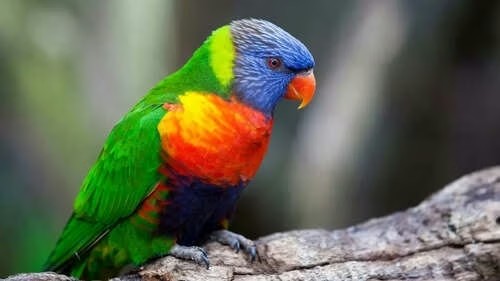
Rainbow Lorikeet
The Rainbow Lorikeet comes from Australia and has also been seen in Tasmania, New Zealand, and Hong Kong. Its feathers are a bright mix of blue, green, red, and orange. These active parrots live in rainforests and coastal woodlands, and their colourful look and lively behaviour make them easy to spot. (Trichoglossus moluccanus)
As its name suggests, this bird looks like a flying rainbow. Native to Australia, the Rainbow Lorikeet is a burst of color. It typically has a deep blue head, a bright orange-yellow breast, a green back and wings, and red on its beak. They are small, extremely active, and playful birds, and their brush-tipped tongues are specially adapted for feeding on nectar and pollen. The Rainbow Lorikeet (Trichoglossus moluccanus) is a dazzling parrot species native to Australia, known for its vibrant plumage and playful personality. Here’s a colorful snapshot of this feathered marvel:
🌈 Key Facts About the Rainbow Lorikeet
Conservation Status: Listed as “Least Concern” by the IUCN, though they’ve been introduced to places like Perth, Tasmania, Auckland, and Hong Kong.
Habitat: Found along Australia’s eastern seaboard, from northern Queensland to South Australia. They thrive in rainforests, coastal bush, and woodland areas.
Appearance: Their feathers are a kaleidoscope of colors—bright blue head, green wings and back, orange-yellow breast, and red beak.
Diet: Primarily nectar and pollen from flowers, supplemented with fruits. Their brush-tipped tongues help them lap up nectar efficiently.
Behavior: Highly social and noisy, often seen in pairs or flocks. They’re known for their acrobatic feeding habits and playful antics.
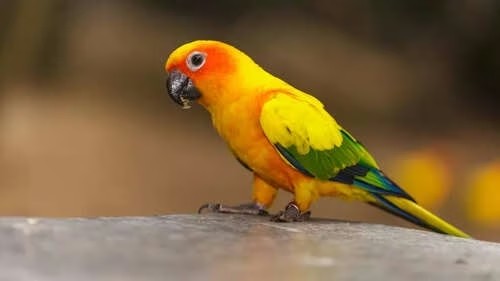
Sun Conure
The Sun Conure lives in northern South America, including parts of Brazil, Guyana, Suriname, and French Guiana. Its yellow and orange feathers make it very noticeable in tropical areas. Social and active, the Sun Conure is a favourite among bird watchers for its bright colours and lively personality. (Aratinga solstitialis)
The Sun Conure, or Sun Parakeet, is a medium-sized parrot from South America, renowned for its incredibly bright and fiery coloration. Adults are a stunning blaze of golden-yellow, with fiery orange blushes on the face and belly, and wings tipped with green and blue. Their vivid, sun-like appearance makes them one of the most popular and visually striking conures. The Sun Conure (Aratinga solstitialis), also known as the Sun Parakeet, is a radiant burst of color and personality in the parrot world. Here’s a vibrant look at this tropical treasure:
🌞 Sun Conure Highlights
Conservation Status: Endangered due to habitat loss and trapping for the pet trade.
Origin: Native to northeastern South America, especially Brazil and Guyana.
Appearance: Adults sport golden-yellow plumage with orange-red faces and underparts, accented by green and blue-tipped wings and tails.
Size: Medium-sized parrot, typically around 12 inches (30 cm) long.
Diet: Enjoys fruits, seeds, nuts, flowers, berries, and insects.
Social Behavior: Extremely social and affectionate. They form monogamous pairs and live in flocks.
Personality: Playful, intelligent, and expressive—but also very loud! Their vocal nature makes them better suited for experienced bird owners.
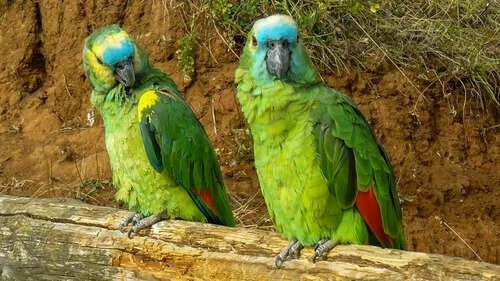
The Blue-Fronted Amazon is mostly green with a light blue patch on its forehead and yellow near its eyes. Known for being smart and good at talking, this parrot has simple but attractive colours that make it stand out among Amazon parrots.
Green-Winged Macaw
The Green-Winged Macaw is one of South America’s largest and most colourful parrots. Its body and head are mostly red, with green and blue on its wings and tail. Found in rainforests and savannahs, this macaw impresses with its size and bright colours, making it a true symbol of tropical wildlife.
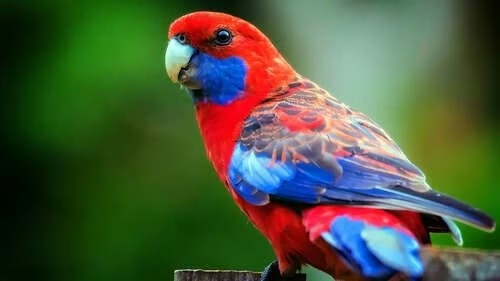
Crimson Rosella
The Crimson Rosella is a medium-sized parrot from Australia, also found in New Zealand and Norfolk Island. It has deep red feathers and a long tail, giving it an elegant look. Often seen in forests and gardens, it is loved for its bright colours and graceful appearance.
Parrots are among the most intelligent birds
Parrots have exceptional problem-solving skills and can mimic human speech, sounds, and even understand simple concepts. Some species, like the African Grey Parrot, are known to recognize words and use them meaningfully.
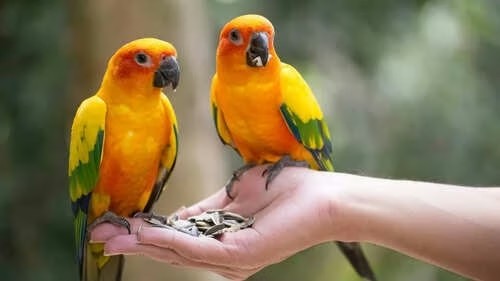
Their feathers are naturally vibrant
The bright colours of parrots — red, green, blue, and yellow — come from unique pigments and feather structures that reflect light, not from dyes or food.

Exceptional memory
Parrots have excellent memory skills. They can remember food locations, recognize faces, and recall sounds they’ve heard long ago.
Their colourful feathers serve a purpose
Parrots’ bright feathers aren’t just for show—they help them blend into tropical flowers and leaves in the wild. Their colours also play a role in attracting mates and showing good health.

More than just colourful birds
Parrots are not only beautiful but also full of personality, emotion, and intelligence. Their lively colours, playful nature, and close bonds with both their flocks and humans make them one of nature’s most remarkable creations.
While beauty is subjective, here are 5 parrot species that are widely considered to be among the most stunning in the world due to their vibrant and unique plumage.
Scarlet Macaw
Perhaps the most iconic of all parrots, the Scarlet Macaw is a dazzling spectacle of primary colors. Its body is covered in brilliant scarlet red, with bright yellow and deep blue feathers covering its wings. Native to the tropical rainforests of Central and South America, its sheer vibrancy and large size make it an unforgettable sight.
Hyacinth Macaw
The Hyacinth Macaw is a breathtaking bird — a true marvel of nature. Here’s a detailed look at this magnificent species:
🦜 Overview of the Hyacinth Macaw
- Scientific Name: Anodorhynchus hyacinthinus
- Common Names: Hyacinth Macaw, Hyacinthine Macaw
- Conservation Status: Vulnerable (IUCN Red List)
🌍 Habitat & Range
- Native to central and eastern South America, especially Brazil’s Pantanal region.
- Prefers savannas, woodlands, and palm swamps, where it can find its favorite food: nuts from native palms.
📏 Physical Characteristics
- Size: Up to 100 cm (about 3.3 feet) long — the largest flying parrot species in the world.
- Wingspan: 130–150 cm
- Weight: 1.2–1.7 kg
- Color: Vibrant cobalt blue feathers with striking yellow skin around the eyes and beak.
🧠 Behavior & Lifestyle
- Highly intelligent and social, often seen in pairs or small groups.
- Diurnal — active during the day.
- Known for their powerful beaks, capable of cracking hard nuts like macadamias and Brazil nuts.
🐣 Lifespan & Reproduction
- Can live up to 50 years in the wild or captivity.
- Breeding pairs nest in tree cavities and typically raise one chick at a time.
🏠 As Pets
- While stunning, they are not easy pets:
- Require ample space to fly and exercise.
- Need constant mental stimulation and social interaction.
- Can be extremely loud and demanding.
- Protected under CITES Appendix I, meaning international trade is tightly regulated.
Hyacinth macaws have impressive cobalt blue feathers, which contrast with their bare yellow eye ring (which, in other species of macaw is white) and the yellow patch of skin beside the lower bill. Their irises are dark-brown in color and their feet are dark gray. Females and males are nearly indistinguishable, but the females are typically a little more slender. On juveniles, the upper bill is paler and the tail is shorter.
Photos with Hyacinth Macaw




The Hyacinth macaws are native to central and eastern South America and now inhabit only three distinct areas: the Pantanal, a natural region of Brazil, Bolivia, and Paraguay; The Cerrado, a tropical savanna ecoregion of Brazil; the eastern Amazon Basin of Brazil. Hyacinth macaws are found in palm swamps, woodlands, and other semi-open, wooded habitats. They usually avoid dense, humid forests and often inhabit savannah grasslands, dry thorn forests known as ‘caatinga’, and palm stands.

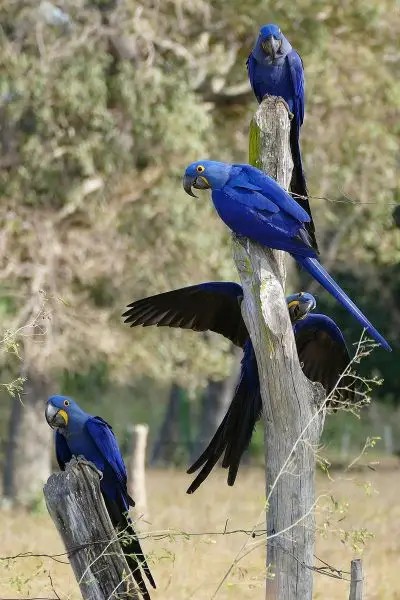
Habits and Lifestyle
Hyacinth macaws are very social birds. They can be seen alone but usually form groups of up to 4 birds. They are also often found in bigger groups of between 12 and 20 birds, which often include pairs and family trios (parents and chick). They feed mainly during the morning and the late afternoon and are sometimes active on moonlit nights. During the heat of the day, they rest in the canopy. Pairs stay close to each other. On being disturbed, they fly out of the canopy to circle over treetops, making their loud calls. They are very noisy birds.
Hyacinth macaws are monotonous and usually remain with one partner their entire life. They produce one brood per season and don’t breed every year, breeding after the rainy season, which is July to December. They make their nests in cliff faces or tree cavities, depending on what is available. 1 or 2 eggs are laid, the second being several days later than the first. Incubation is done by the female, for about a month, and the male brings her food during this period. Chicks fledge around 4 months after hatching. Often the smaller chick dies, so only one survives. Chicks remain with their parents for around 6 months and both parents feed them. These birds reach reproductive maturity at the age of 7 to 10 years.
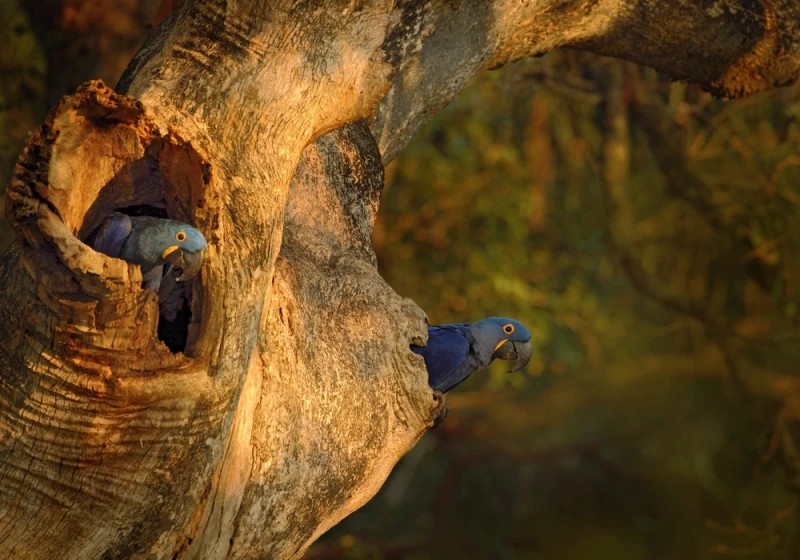
Population
Population threats
Hyacinth macaw numbers are in decline due to the illegal pet trade (being highly prized as pets) and habitat loss. Their habitat is being lost or changed due to cattle ranching and mechanized agriculture, as well as hydroelectric schemes. Some native people hunt these birds for their colorful feathers for use in headdresses or other souvenirs for tourists.
Population number
According to the IUCN Red List, the total population size of Hyacinth macaws is 6,500 individuals (including 4,300 mature individuals), of which 5,000 individuals are in the Pantanal region. Hyacinth macaws’ numbers are decreasing today and they are classified as Vulnerable (VU) on the IUCN Red List.
Ecological niche
Hyacinth macaws have an important part to play in their ecosystem through the dispersal of nuts and seeds throughout their territory.
Fun Facts for Kids
- Hyacinth macaws are often considered to be gentle giants, with loving and gentle personalities.
- To avoid being eaten by Hyacinth macaws, palm trees produce harder and harder nuts over time. Some macaws with very big beaks can open these nuts. Their young get larger and heavier beaks from their genes, and so beaks become bigger in each new generation.
- The macaw uses its beak to score a mark in the nut. Then, as a cutter does, it slices the nut into two halves, cutting very cleanly, almost like human work.
- Hyacinth macaws can mimic human voices.
- When in flight, the Hyacinth macaw makes a guttural and discordant “kraaa-aaa”, repeating these sounds in bursts. When roosting, it makes barks, yelps, and growls.
- When disturbed, these macaws screech loudly, circling overhead while their long tails stream out behind them.
- The acuri nut, which is a favorite of the hyacinth macaw, is so hard that the bird cannot eat it until it has been digested by cattle.
- Hyacinth macaws sometimes eat clay, which helps them absorb the poison that naturally occurs in some unripe fruits and seeds. These mountains of clay are called “macaw licks”.
The Hyacinth Macaw is the largest of all flying parrot species, and its beauty is both striking and elegant. It is famous for its breathtaking, solid cobalt-blue plumage. This deep blue is perfectly contrasted by bright yellow rings around its eyes and at the base of its large, powerful black beak. Found in South America, its majestic appearance is truly one-of-a-kind.
Eclectus Parrot (Eclectus roratus)
The Eclectus Parrot is so beautiful and unique that males and females look like two entirely different species—a trait known as extreme sexual dimorphism.
- The male is a brilliant, almost electric, green with splashes of red and blue under his wings and a candy-corn-colored (orange) beak.
- The female is a stunning combination of deep crimson, royal blue, and rich purple, with a jet-black beak. Native to the Solomon Islands, New Guinea, and northeastern Australia, both sexes are equally breathtaking.
The Eclectus Parrot (Eclectus roratus) is one of the most visually striking and biologically fascinating parrots in the world. Here’s a deeper look at what makes them so special:
🦜 Eclectus Parrot Overview
- Scientific Name: Eclectus roratus
- Common Names: Eclectus Parrot, Red-sided Parrot, Rocky River Parrot
- Conservation Status: Least Concern (IUCN)
🌈 Sexual Dimorphism: A Stunning Contrast
- Males: Bright emerald green with blue wing accents and red underwing coverts. Their beaks are orange.
- Females: Deep red head and body with purple-blue chest and tail. Their beaks are black.
- This extreme difference in coloration led early ornithologists to mistakenly classify them as two separate species.
🌍 Habitat & Range
- Native to Papua New Guinea, Indonesia, and parts of northern Australia.
- Found in dense tropical rainforests, often near water or coastal areas.
📏 Physical Characteristics
- Size: 43–45 cm (17–18 inches) including tail
- Weight: Around 400–600 grams
- Voice: Loud and distinctive calls; they screech when disturbed and chatter frequently.
🧠 Behavior & Intelligence
- Highly social and intelligent, capable of mimicking human speech.
- Known for their gentle temperament, especially males.
- Females tend to be more territorial, especially around nesting sites.
🐣 Breeding & Lifespan
- Nest in tree hollows, often high above ground.
- Females may remain in the nest for extended periods, while males forage and bring food.
- Lifespan can reach 30–50 years in captivity.